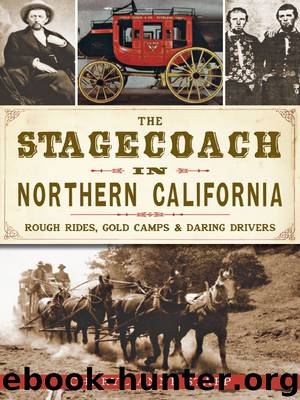The Stagecoach in Northern California by Cheryl Anne Stapp

Author:Cheryl Anne Stapp
Language: eng
Format: epub
Publisher: Arcadia Publishing Inc.
Published: 2014-12-10T16:00:00+00:00
HIGHWAYMAN CHARLES BOWLES, AKA BLACK BART
It was a lovely summer morning on July 26, 1875, when driver John Shine set out from Sonora on his regular stage run to Copperopolis and Milton. He carried five passengers inside and the Wells Fargo Express strongbox at his feet, containing $300 in gold dust. After crossing the Stanislaus River on Reynold’s ferry, Shine’s team made the long, slow climb up Funk’s Hill. Suddenly, a figure clad from shoulders to heels in a linen duster slipped from behind a roadside boulder, crouched in front of the startled leaders and aimed a double-barreled shotgun at Shine’s head. A flour sack slit with peepholes masked his face. The assailant’s deep voice tersely commanded Shine to throw down the treasure box, which he did after quickly looking about and seeing what he thought were several shotguns sticking out from the bushes. As the box hit the ground, the robber stood up, looking to be over six feet tall. He came back toward the coach with quick, springy steps, demanding the mail sacks. Shine’s female passenger panicked and tossed her satchel out the window. The robber bowed courteously and returned it to the lady, declaring that he only wanted the goods belonging to Wells Fargo. Gathering up his loot, the highwayman ordered Shine to “hurry along” and faded into the brush.
Lawmen rushed to the scene, where they discovered that the “shotguns” Shine had seen were merely sticks artfully stuck between the boulders, a trick that the clever bandit would repeat on his next holdup in Yuba County on December 28, 1875, one hundred miles north of Funk’s Hill. On June 2, 1876, an identical stage robbery occurred in Siskiyou County, more than two hundred miles farther north. In each case, the description of the robber was the same: he was six feet tall, physically agile, had a deep voice and spoke perfect English. He wore a flour sack over his face, appeared to be on foot and left no other clues except for a taunting bit of poetic drivel scrawled on the back of a Wells Fargo waybill that he left at the scene of his fourth robbery near Duncans Mills (Sonoma County) in August 1877:
Here I lay me down to sleep
To wait the coming morrow,
Perhaps success, perhaps defeat
And everlasting sorrow.
I’ve labored long and hard for bread
For honor and for riches
But on my corns too long you’ve tread
You fine haired Sons of Bitches.
Yet come what will, I’ll try it once,
My conditions can’t be worse,
And if there’s money in that box,
’Tis money in my purse.
Black Bart, the Po8
Download
This site does not store any files on its server. We only index and link to content provided by other sites. Please contact the content providers to delete copyright contents if any and email us, we'll remove relevant links or contents immediately.
| Africa | Americas |
| Arctic & Antarctica | Asia |
| Australia & Oceania | Europe |
| Middle East | Russia |
| United States | World |
| Ancient Civilizations | Military |
| Historical Study & Educational Resources |
Cat's cradle by Kurt Vonnegut(14758)
Pimp by Iceberg Slim(13777)
Underground: A Human History of the Worlds Beneath Our Feet by Will Hunt(11837)
4 3 2 1: A Novel by Paul Auster(11790)
The Radium Girls by Kate Moore(11621)
Wiseguy by Nicholas Pileggi(5316)
American History Stories, Volume III (Yesterday's Classics) by Pratt Mara L(5133)
Perfect Rhythm by Jae(5070)
The Fire Next Time by James Baldwin(5016)
Paper Towns by Green John(4797)
Pale Blue Dot by Carl Sagan(4614)
A Higher Loyalty: Truth, Lies, and Leadership by James Comey(4550)
The Mayflower and the Pilgrims' New World by Nathaniel Philbrick(4279)
The Doomsday Machine by Daniel Ellsberg(4245)
Killers of the Flower Moon: The Osage Murders and the Birth of the FBI by David Grann(4188)
The Sympathizer by Viet Thanh Nguyen(4093)
Too Much and Not the Mood by Durga Chew-Bose(4091)
The Borden Murders by Sarah Miller(4015)
Sticky Fingers by Joe Hagan(3911)
